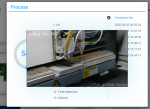- Messages
- 20,157
- Location
- Springfield, Missouri
I know a few of you dabble in electronics. Just curious what others are using for their circuit designs and whom they usually order boards from?
I had started out trying Eagle, switched to Fritzing for a short time, then tried KiCad. Either I just didn't find them easy to use or couldn't figure out how to get my design out to order. Lately I've been using an online/browser based designer called EasyEDA (https://easyeda.com/). They seem to have a lot of components and user submitted components already available, without having to go import them or design yourself as in the others I've tried.
Once the design is done and you want to export it, there is a quality and trace check, they then prompt with the option to use their partner JLCPCB to order the boards. I tried that option and for 100 mm x 100 mm boards, 2 sided, it's been $5 for 10. The shipping options are slow boat from china for $8 or $18 for DHL. The slow boat took about a month to arrive. I just made the last order using DHL on Friday and it says it should arrive this Friday.
This one was one of the first boards I've had done, seems to be of good quality. The re-designed version I sent on Friday is a little better layout and traces are a little more organized as I'm starting to get used to their software now.

They also have a partner to install any SMD components you're using for you. I may try that will a future order
I had started out trying Eagle, switched to Fritzing for a short time, then tried KiCad. Either I just didn't find them easy to use or couldn't figure out how to get my design out to order. Lately I've been using an online/browser based designer called EasyEDA (https://easyeda.com/). They seem to have a lot of components and user submitted components already available, without having to go import them or design yourself as in the others I've tried.
Once the design is done and you want to export it, there is a quality and trace check, they then prompt with the option to use their partner JLCPCB to order the boards. I tried that option and for 100 mm x 100 mm boards, 2 sided, it's been $5 for 10. The shipping options are slow boat from china for $8 or $18 for DHL. The slow boat took about a month to arrive. I just made the last order using DHL on Friday and it says it should arrive this Friday.
This one was one of the first boards I've had done, seems to be of good quality. The re-designed version I sent on Friday is a little better layout and traces are a little more organized as I'm starting to get used to their software now.

They also have a partner to install any SMD components you're using for you. I may try that will a future order


